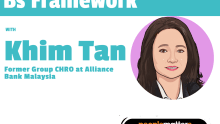Being Real in an Artificial World—Strategies for the Future of Your Work

Every part of the world is becoming increasingly mediated by advanced technology. From AI to advanced robotics to New technologies are being dispersed into mature systems and pressed upon people who may or may not be prepared to work with them. And it will not stop any time soon, says top futurist Benjamin Pring, Head of Thought Leadership and Managing Director of Cognizant's Center for the Future of Work.
"Everything that can go online is going to go online. We think we're living in an online digital world already, but the reality is, we've only scratched the surface of where technology is going to take us in the next few years," he points out.
So, how can HR leaders today create and maintain a balance between people and machines, and how they can optimize the relationship between machines and humans?
Learn how to manage in the "wirearchical" world
Organizations, especially large ones, are moving from a hierarchical mode to a wirearchical model, says Pring—wirearchical meaning that power is distributed and dispersed throughout the networks rather than being concentrated within a traditional command and control structure. "The real power isn't just at C level, but with the people lower down in the organization who are doing the work," he says.
That tension is manifesting in how businesses innovate, in how they advance, and HR leaders will have to quickly learn how to manage in a wirearchy rather than the hierarchy they might be used to.
Understand that the aesthetics of work are changing
What work looks like has changed. With remote work becoming the norm, the culture of presenteeism that pervades many businesses has taken a major blow. Physical trappings like what one wears while working have lost their importance. Instead, according to Pring, the emphasis is now on what tools—software tools—we use, and how well we use them.
"This might seem trivial, but it's actually not, because a lot of big businesses are struggling to manage the transition and understand the underlying dynamics creating it. Struggling to understand the new tribe of software engineering people that are increasingly influential and leading in big businesses," he said. "HR people have to understand these dynamics and optimize for them."
Be aware that work itself must be balanced with downtime
In today's world, it's become all too common to be constantly connected and always on. But this is ultimately detrimental to people's ability to be valuable members of the business and of society, says Pring. "We have to balance our ability to be present, to be productive, and to contribute against our underlying sanity and our underlying humanity."
HR leaders are again in the position of having to manage this shift and implement, for employees, the balance that they may not be able to deal with on their own.
Most of all: express the human connection
Cognizant's research on the HR jobs of the future has found that while technology is central to the future of our work, not all jobs will have a technology component, nor will they all require us to be technologists. What will instead be required of everyone is the ability to create and maintain the human connection.
"In this moment of artificiality, it's increasingly important that HR leaders express the authenticity, the human connection, the need for humans to be real," Pring advises. "That, I think, is going to be the differentiator between leaders who can thrive in the future world of work, and those who take a cul-de-sac which we as real people don't want."
This article is based on Benjamin Pring's talk at TechHR India 2020.












